|
Olympus Evolt E-330 with PT-E02 Underwater Housing
All-purpose digital SLR with live view LCD and professional quality underwater housing system
(by Conrad H. Blickenstorfer and Carol Cotton Walker)
At this year's PMA -- the Mecca of shows for professional photographers -- Olympus product manager Sally Smith Clemens pointed out that in the digital era, unlike in the olden days of film, cameras change very quickly. "In electronics, the technology is constantly evolving, and we want to bring the new innovations to our customers as soon as we can," Smith Clemens
said in an interview with
USA Today.
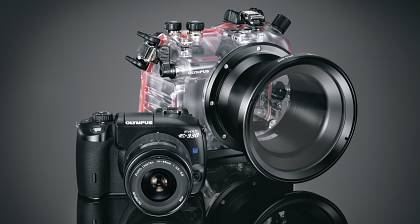
And things indeed change quickly. No sooner did we complete a detailed review of the Olympus Evolt E-330 that the company revealed its 10-megapixel Evolt E-410 and E-510 models. Does that mean the E-330 is already obsolete because its maximum image resolution is 7.5 megapixel instead of 10? Not really. Newer is (almost) always better, but we found the E-330 to be an exemplary digital SLR, one that worked beautifully, took great shots, and, best of all, gave us a chance to test it not only for everyday shooting, but also underwater, in full scuba gear. Above you can see how substantial the waterproof housing is. Yes, we probably took more pictures in the depths of sinkholes, caverns, and rivers than we took on the surface. That's with the extensive, professional-quality PT-E02 underwater housing, of course, and we'll get into that.
As is, the Evolt-330 is a formidable camera. It has most of the same technologies used in the just released E-410 and E-510 models, and now that the new cameras are out, the E-330 may come down in price (it was originally more expensive than the two new dSLR offerings).
The "Four Thirds" system
What you get with the Evolt E-330 is a full-function digital single lens reflex camera that uses the Four Thirds Mount System developed by Olympus and Kodak specifically for digital SLRs and used by several other camera companies. A word about the Four Thirds system: The name “Four Thirds” comes from the 4:3 aspect ratio of the sensor. That's different from the 1.5 ratio used in the old 35mm film, but the same as that in all conventional computer monitors and TVs (albeit not the same as the wider formats predominantly used now). The sensor used in Four Thirds systems measures 18 x 13.5 millimeters as opposed to the traditional 36 x 24mm film “sensor” area. This allows for more compact lenses suitable for digital SLRS that can also be more compact than traditional film SLRs. To learn more about the Four Thirds system, check its official website at http://www.four-thirds.org/en/index.html.
The standard kit comes with a 14-45mm Zuiko lens. In the Four Thirds system, 14-45 translates into 28-90mm in 35mm film equivalent. Ours, which we intended to use primarily underwater, came with an 11-22mm f2.8-3.5 – or 22-44mm in 35mm parlance – lens with superb light gathering.
Like most SLRs, even most digital ones, the Evolt-330 is large. It is a camera in the traditional sense of the word, not one of those 10-megapixel ultra-slim techno-slivers that you stick into any pocket. And the size also depends on the lens. The bare camera body, sans lens, measures 5.5 x 3.4 x 2.8 inches and weighs almost 20 ounces without battery or cards. That's a bit larger and heavier than the new E-410/510 duo that was just announced, so technology marches on in miniaturization as well. As substantial as it is, anyone used to a standard SLR will definitely not be put off by the 330's size.
"Live View" on a terrific LCD
Right off the bat, there is much to like about the 330. It starts with something we've come to expect from digital cameras, but that's still almost a novelty with digital SLRs: a Live View LCD. Traditionally, SLRs use a through-the-lens viewfinder that presents a totally accurate view of what the picture will look like. That's great, but it also means you need to look through it when you take a picture. Not very inconspicuous. So, in addition to the optical viewfinder, Olympus gave the E-330 what was at its introduction the world's first live view LCD.
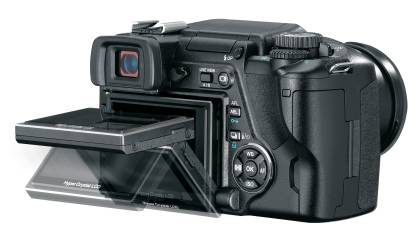
And it's not a fixed one either. You can pull it out and then rotate it so that you can hold the camera at hip level and look down onto the LCD, or you can hold the
330 above your head to shoot over the heads of a crowd, and you can still see the downward-tilted LCD. Better yet, the 2.5-inch diagonal LCD is large enough to see what's going on and its 215,000 pixel resolution means you can zoom in (up to 14X) and get a very good feel for whether the picture is sharp or not. The LCD uses Olympus' HyperCrystal technology that makes for a vibrant display, and,
perhaps best of all, the LCD has a very wide viewing angle from all sides. Olympus claims 160 degrees, but it's really more like a full 180.
Two card slots
There are other goodies. For example, we've often criticized Olympus for its use of the xD-Picture card that generally costs a bit more and isn't as easy to find as the more popular SD Card and older CF card formats. Well, the E-330 has an xD-Picture card slot as well as a CF Card slot, so you can use both. And you can even copy from one to the other, which comes in handy if your computer can read CF cards but not xD cards. With the ever-increasing storage capacity of memory cards the MicroDrive – a hard drive in CF Card format – isn't as important as it once was, but the E-330 can accommodate that also.
Dust reduction technology
Another cool technology you find in the E-330 is its Dust Reduction System. Why do you need it? Because dust and other particles have always been the bane of SLR cameras where the mirror is exposed when you exchange lenses. That can result in
specks and artifacts on the picture.
Olympus combats that with a rather ingenious technology. A “SuperSonic Wave Filter vibrates with a frequency of 35,000 times a second to remove any dust and other stuff that might have settled on the sensor. You're reminded of that every time you turn the camera on via its large on/off level rotating around the mode dial: an icon shows up and then the words "Dust Reduction."
TruePic processor
And there's more high technology in the form of the Olympus TruePic TURBO Image Processor that speeds up image capture while also micro-smoothing pixels for bright and visually more pleasing pictures. It's hard to quantify the benefit of all those processors
and special chips in today's cameras, but we certainly can't argue with the results. The E-330 delivered consistently excellent pictures.
Hybrid technologies
Technology also breaks through other barriers and blurs former differentiation between camera types and styles. In the past, compacts were mostly automatic point & shooters whereas SLRs were manually operated with perhaps a couple of program modes thrown in. That is now changing. The E-330's large mode dial has the usual Manual, Aperture-priority, Shutter-priority and Program modes, but you can also quickly select portrait, landscape, macro, sports and nighttime settings. But that's still not all. There's also a compact-style selection of "Scenes," preconfigured settings for special shooting situations. There are 20 of them. Each first shows a sample picture, then a brief description.
A comment here: Compacts often have dozens of "scenes" these days. That's nice, but what often bothers me is that I
usually don't get to know what settings the camera uses for each mode. Well, you don't have that problem with the E-330. Push its “Info” button and the big LCD shows either basic or full settings details for each mode. In live view mode where you can also use the “Info” button to toggle between a full picture display or one with vital image data superimposed.
In playback mode you can, via that same handy Info button, view a picture in seven different ways: as is; showing the card used, quality and picture number; that plus the date, pixel size and shutter speed; a small pic with four histograms and all pertinent image information; a full pic with superimposed opaque histrogram; a pic that shows just blown out highlights; a pic that shows just blown-out shadows.
Easy to use, with some caveats
SLRs do not generally have a reputation for great ease-of-use. While today's compacts seem to have settled on a very standardized user interface and hardware control arrangement, SLRs tend to have buttons, levers and controls all over the place. The E-330 is no exception, and so a few hours' worth of reading, studying and practicing is a very good investment in time before the first serious photo outing.
Truth be told, Olympus could have helped out more in the menu department. There is a Menu button that brings up vertically tabbed walking menus. Those use that unfortunate mesh of text, icons and illustrations that camera makers the world over employ to befuddle users, or so it sometimes seems. Frankly, it's just a drag to have to memorize dozens of funky icons and pictograms when the screens are now large enough and have high enough resolutions to simply spell things out. That gibberish is bad enough on menus where there is always a shortage of real estate, but it is downright inexcusable with things like exposure metering where there's plenty of space to describe those often unintelligible icons.
That out of the way -- and we do hope the camera makers will eventually take notice -- the E-330 is not difficult to use once
you've familiarized yourself with the camera and its functions. In fact, you can leave it in Program mode all day long and just shoot. Chances are you'll get great shots. More advanced photographers will find plenty of options to set up great shots and go for special effects.
A word of caution to beginning photographers who expect a big digital SLR to be able to do it all. It's not so. Despite their size, current dSLRS like the E-330 don't do such
presumably mundane things as taking movies or recording sound. In that sense, SLRs have stayed true to their origin. Their purpose is to shoot high quality pictures.
Assorted specs we like
In terms of specifications, here are some of the ones that matter: You can record as JPEG, TIFF or RAW. When shooting in RAW, you can also save a JPEG image in addition. Exposure compensation is not fixed, but can go in 1, ˝, or 1/3 EV step increments from plus to minus 5EV. Shutter speed ranges all the way from 1/4000 of a second to a full eight minutes in bulb mode. Sequential shooting yields about three frames per second. There's a built-in flash in addition to a hot shoe for a (recommended) external flash. The battery is a beefy 7.2 Volt, 1,500mAH Li-Ion rechargeable. You can do exposure bracketing and have great influence over color settings: color space, picture mode, sharpness, contrast, saturation, filters, toning and gradation. It all adds up to remarkable flexibility.
Underwater shooting
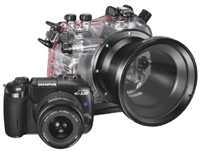 As mentioned above, we probably shot more pictures underwater than above with the E-330. That requires the PT-E02 Underwater Housing shown to the left (without the exernal flash housing we also used). It is a durable, very high quality, transparent polycarbonate housing specifically designed for the E-330 and allows you to take the camera down to about 200 feet. That is significantly deeper than the recreational scuba diving limit of 133 feet, and emphasizes the E-330's professional character not only for picture taking, but also for serious diving. As mentioned above, we probably shot more pictures underwater than above with the E-330. That requires the PT-E02 Underwater Housing shown to the left (without the exernal flash housing we also used). It is a durable, very high quality, transparent polycarbonate housing specifically designed for the E-330 and allows you to take the camera down to about 200 feet. That is significantly deeper than the recreational scuba diving limit of 133 feet, and emphasizes the E-330's professional character not only for picture taking, but also for serious diving.
Serious business
Note that unlike the fairly handy and simple underwater cases for compacts, the PT-E02 case for the E-330 is serious business. 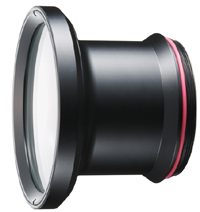 It alone costs more than the entire camera including lens, and that's before you add the underwater housing for the almost always required external flash and the bracketry that holds it all together.If you go to the Underwater accessories page for the E-330, you'll find that there are no fewer than 20 offerings, for the underwater setup alone. If you gear up, it'll cost $1,219.99 for the bare underwater case, $459.99 for the lens port for our 11-22mm lens, $679 for the PFL-E01 flash housing, a rather steep $179.99 for a flash bracket, another $89.99 for the cable, and a bunch more for this and that. It adds up and it is a serious commitment. It alone costs more than the entire camera including lens, and that's before you add the underwater housing for the almost always required external flash and the bracketry that holds it all together.If you go to the Underwater accessories page for the E-330, you'll find that there are no fewer than 20 offerings, for the underwater setup alone. If you gear up, it'll cost $1,219.99 for the bare underwater case, $459.99 for the lens port for our 11-22mm lens, $679 for the PFL-E01 flash housing, a rather steep $179.99 for a flash bracket, another $89.99 for the cable, and a bunch more for this and that. It adds up and it is a serious commitment.
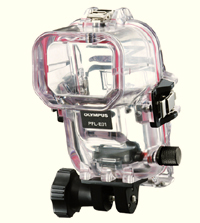 Is it all worth it? For the serious underwater photographer, absolutely. But it is a lot of money and it is meant for professional quality marine photography. Those who just want to snap some shots will likely be much happier with an inexpensive, small and handy underwater digicam such as the Olympus Stylus 770 SW. Is it all worth it? For the serious underwater photographer, absolutely. But it is a lot of money and it is meant for professional quality marine photography. Those who just want to snap some shots will likely be much happier with an inexpensive, small and handy underwater digicam such as the Olympus Stylus 770 SW.
Rather than just admiring the fancy gear, we took the Evolt E-330 and its extensive underwater system on a genuine dive trip. We spent many hours underwater with it and gave it a good workout in a variety of very different dive sites.
We first took it to the Devil's Den cavern/sinkhole at Williston, Florida and used it there, with relatively little
priot familiarization with the camera. We planned on setting the flash to TTL-Auto mode, which works perfectly with the Evolt 330, and
setting the Evolt itself to its underwater "scene" mode. So the first round of pictures
would be done entirely in point & shoot mode, at depths around to about 50 feet.
But before we got in the water, there were a few things to be considered.
Preparing the Olympus for a dive
If you are new to the world of SLR underwater cases, it's very different from
placing a compact camera into its handy deepwater case. There, you just insert the camera and close the case, and you're all set. An SLR case, especially with external flash, is much more involved. Since SLRs come with different lenses, the lens ports for each lens are different. Cables are needed and brackets, and the brackets need to be assembled properly. There are numerous
O-rings that must be checked for proper sealing, and there are ports that may need
sealer caps if they are not used. Instead of just closing a case, you really need a checklist, if only a mental one, to make sure you haven't forgotten anything. Even inserting and securing a big SLR into the case is a task that requires practice. There is a ring that operates the zoom lens and it needs to fit just right. There are brackets and supports and control connections that all must be
installed properly or else. The rubber-cushion frame that makes it more
comfortable to look through the viewfinder had to be removed to make the camera fit, and we promptly lost it. And several small parts are also still unaccounted for, though we'll likely find it in our dive gear.
Once you're all set up you have a large, bulky, heavy rig. Traveling with it means making triple-sure you don't forget
any part of the whole assembly or you can forget about taking
underwater pictures. And it needs to be disassembled and stowed away and packed so it won't get damaged, not an easy task with all the parts. I actually got it all into a carry-on, in addition to enough light clothing for a four-day dive trip, my dive computer and my regulator, and an assortment of cables and power supplies. Amazingly, the bag made it through the x-ray security machine without raising any questions at all. I wish my sneakers, toiletries and laptop computer were so lucky.
Testing it and impressions
All set up in our wetsuits and scuba gear we carefully lowered the Olympus rig into the water
at Devil's Den to see if there were any leaks or telltale bubbles. I must admit, the first time I dunked the big
camerabelow the surface I was sweating bullets in my wetsuit. But all was well. No leaks, no bubbles.
Next we took it two feet under the surface and let go to test its buoyancy. The setup had felt rather heavy and we wondered if if it would float. After all, a scuba tank is also very heavy, and yet it floats. Unfortunately, the Olympus is no scuba tank and does not float. In fact, it turned out to be very negatively buoyant. So do not let go of this rig, ever! However, swimming around with it and handling it was surprisingly easy, at least for my co-reviewer who is an experienced NAUI scuba instructor and underwater photographer. Me, I can see that the negative buoyancy might at first be an issue for newer divers.
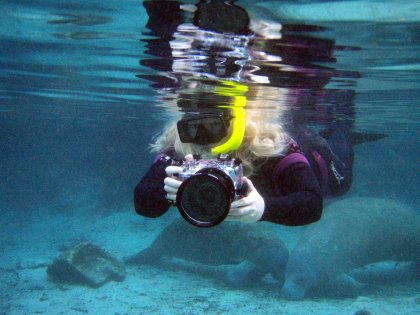
A sizeable case
Considering the relatively compact size of the camera, the case is bulky, but not
excessively so. In all honesty, it needs to be the size it is in order to be not more negatively buoyant as it is. The dome port is large and heavy and adds perceived bulk. It is probably necessary to provide that much space for the wide angle, but there is still a good inch of space between the lens and the glass of the port. The
very prominent flare is probably necessary in order not to get vignetting. We wished it'd have been even half an inch shorter as we swam around rocks and through openings. We also felt it must be a nightmare for designers to make all these housings for every new camera, given that the market is not that large.
To flash or not to flash
Here I should mention that I was very tempted to just take the camera on the first dive and leave the flash with its large and very heavy bracket behind. The flash housing itself is also rather large, and has to be. There's simply no way around it. It is
acrylic and you can see and operate all controls inside. The flash can be turned in all directions thanks to an intricate system of pivots and joints. One problem here is that if you loosen
the screw or wheel of a joint even a tiny bit, the whole heavy assembly collapses
instead of just giving a bit. A dampener system would be great, but would also make the setup even bulkier and more expensive.
In any case, the external flash is needed. It is the only way to get consistently good pictures underwater, so don't even think about leaving it behind in anything but the clearest shallow tropical water.
Unfortunately, that means another set of batteries (or another rechargeable powerpack)
to watch, as we found out the hard way.
Handles and brackets
Olympus went to great lengths to make the setup as easy to carry and handle as possible. There is a neoprene-padded strap on the flash side of the bracket that
is comfortable and helps with carrying the heavy camera assembly. We found that the strap compresses under water, at depth, and ends gets loose so perhaps a solid, contoured piece might be better. We also really liked the handstrap on the right side of the camera. It's easy to tighten, and helps handling the camera.
We spent a good deal of time speculating how the bracket assembly could be improved, and in what way. However, Olympus' design decisions seemed sound, and the resulting freedom of movement allows for a lot of flexibility in taking pictures.
Put a moisture sensor in it?
A big plus of having a clear polycarbonate housing is that if moisture ever gets in, you can see it. Ample space inside the housing also means ample space for desiccant packs. But since the housing is clear, why not add a little place that has a sensor strip that turns color and shows (preferably not red or orange, but high visibility green) dangerous humidity levels or flooding?
Picture taking
What about pictures? The underwater environment is very different from shooting above ground. You have less time, can see less, have to deal with the bulky scuba equipment, the control buttons on the outside of the housing that go harder and do not offer the same kind of tactile feedback, and, of course, the ever popular low visibility and often unwilling subjects that simply swim away. Given all those caveats and constraints, the Evolt took good pictures right off the bat, in all-automatic mode. Devil's Den was certainly not an ideal venue. The water was clear, but there wasn't much light. We found that in low light conditions the camera sometimes refused to take a shot altogether. That was a bit frustrating in automatic mode, but it really was user error (not using the proper settings) and not being very used to the camera yet.
Still, as the picture of the crabby crab below shows, the Olympus came
through with good shots even when we struggled.
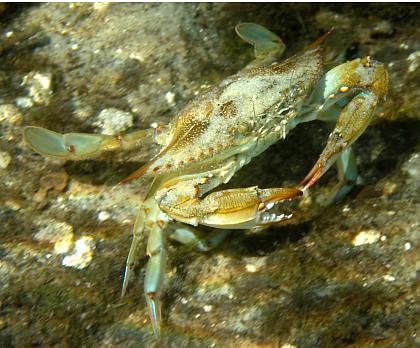
Live preview in action
One great advantage the Evolt has over many conventional underwater SLR cameras is the live preview. That's just a LCD, like all digital cameras have, but underwater, it's often next to impossible to use a viewfinder, what with a mask on, and having the LCD makes a HUGE difference. We never had a problem seeing what we were shooting underwater. We never had to yank the camera up to eye level in front of the mask to take a shot, and thanks to the bright wide viewing angle LCD, we also did not have to move the camera around in order to see the LCD clearly. Another huge advantage.
Diving under different conditions
We ended up taking the Evolt in its housing on several more dives. One actually wasn't a dive at all, just snorkeling and swimming with Manatees at Crystal River, Florida. The Olympus was ideally suited for that, and we also got some very interesting shots with the large lens port half above and half underwater. Such pictures can be priceless.
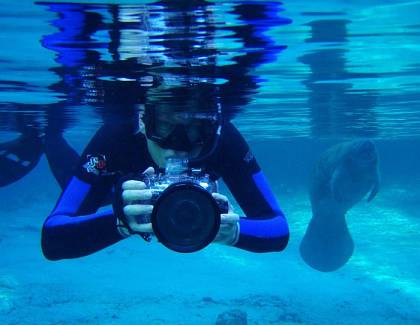
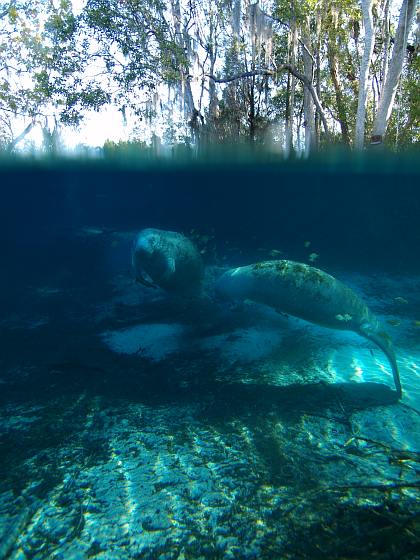
Next we went on a two hour drift dive down Rainbow River at fairly strong currents, and then to the bottom of Catfish Sink at the Manatee Spring State Park near Chiefland, Florida. The 70 foot depth, of course, was no challenge for the tough Olympus housing. But we weren't so sure about the duckweed that completely covered the sink's surface and got into everything. As you can see below, the surface of this dive site definitely does not look inviting or suggest the wonders that lay beneath. Yet, at the end of four days' worth of pretty intense diving, the Evolt and its underwater housing passed with flying colors.
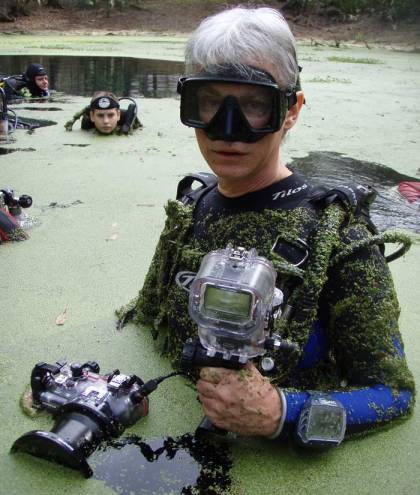
One thing you need to think about is getting the proper lens. Our 11-22mm digital-specific lens was great for underwater where a wide angle always comes in handy. Above water, you quickly want a bit more zoom. If you commit to this setup, and it is a very nice one, you'll likely want to study Olympus' lens offerings (and the underwater lens ports that go with it) in some detail. It's worth it.
Quality construction
The housing seems complex enough for things to go wrong, but the case is very well constructed and survived without as much as a scratch. Neither the camera case nor the flash case ever allowed a single drop of water. The many controls all worked well, though a good degree of familiarization comes in handy, especially if you plan on doing more than use just the automatic mode or underwater scene modes. The only thing that went wrong with the housing was a tiny rubber bumper that popped out just before we packed the camera gear away. I found it on the table and had no idea what it was. We gave the case a careful check-over and found that the little bumper indeed belonged to the case; it was one of four that buffered the front end of the camera against the case. Good thing we found it.
Perhaps best, unlike totally dedicated underwater cameras, when we felt like shooting some Florida sunsets or nature scenes, we could simply take the Evolt out of its housing and use it as a standard SLR, which, of course, it is.
The evolving technology conundrum
One question remains, and it is a serious one. We began this review reminding how quickly digital camera technology advances, and that will not change anytime soon. Spending a lot of money on a setup thus carries a risk as all those professional photographers who spent many thousands on early one and two megapixel digital SLRs will tell.
The risk is somewhat less now as technology has advanced to a point where
it yields incremental rather than dramatic changes and improvements. Yet, we've only had the 7.5 megapixel Evolt E-330 for a few months and it's already been eclipsed by smaller, lighter models with 10 megapixel resolution that cost less to boot. There's nothing that can be done about that. If you buy a computer today, it, too, will be eclipsed in a few months, but it still may do productive work for many years. I still
put a Mac I bought in 1999 to good use. I see no reason why making a substantial investment in a current digital SLR like the Evolt-330 should be any different. With that we can heartily recommend this Evolt to anyone who wants a competent digital SLR for which there is also a full underwater housing system of professional quality.
We like:
- Competent digital SLR suitable for above and underwater use
- “Live View” via bright 2.5-inch wide viewing angle LCD
- LCD can be rotated into different positions (not with housing)
- Polycarbonate underwater housing provides view inside, seals perfectly
- Brackets and pivots allow directing the external flash just right
- Fully automatic settings for beginners yield very good pictures
- Large number of scene modes make for easy picture taking
- Dual card slots (CF and xD)
- Powerful battery
Not so much:
- Onscreen menus needlessly sparse and cryptic
- Underwater assembly with flash is large, negatively buoyant, and has many little parts that can get lost. Brackets and pivots hard to adjust
|










